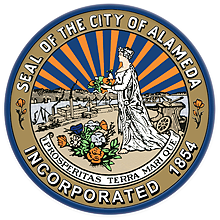COMMUNITY ADVISORY
ctober 31, 2017
FOR IMMEDIATE RELEASE
Contact:
Gail Payne, Transportation Coordinator, City of Alameda
(510) 747-6892
City Council to Consider Draft Transportation
Choices Plan on November 7
The City is tackling transportation issues with a comprehensive citywide plan to provide more transportation options for Alamedans with the goal of reducing thousands of drive alone trips at the crossings and through Alameda over the next 15 years. All community members are invited to review and comment on the City of Alameda’s Draft Transportation Choices Plan, and to discuss the draft plan on Tuesday, November 7 at 7 p.m. at the City Council meeting.
The Draft Plan is located on the City’s project webpage: https://alamedaca.gov/transportation-choices-plan
The purpose of the Transportation Choices Plan is to help ensure that the City sustains its high quality of life during a time of current and anticipated population and employment growth throughout the Bay Area region. During this 18-month citywide planning effort, the City and the consultant team identified numerous diverse and scalable opportunities for strategic transportation investment and coordination with transit operators to provide Alamedans with enhanced transportation options while reducing congestion, our carbon footprint and air pollution. The community engagement process consisted of community workshops, organizational advisory group meetings, a public opinion survey, a project webpage, web-based community surveys, and commissions, boards and City Council meetings.
The Transportation Choices Plan provides an implementation-focused blueprint for how the City can improve transportation infrastructure and services in Alameda over the next 15 years to achieve the two goals discussed below:
Estuary Crossings: Decrease drive alone trips at estuary crossings, especially in the peak period back to 2010 levels of drive alone trips at the estuary crossings before the economy boomed and congestion increased. By implementing the Plan’s proposed projects and programs, it is expected that drive alone trips at estuary crossings will decrease from the expected 2030 baseline of 14,400 drive alone trips in the morning peak hour to 11,900, which is a 17 percent decrease and comparable to 2010 levels of drive alone trips. Staff and the consulting team are recommending this high end estimate as a stretch goal after hearing from community members and the Planning Board and Transportation Commission in September.
Within Alameda: Increase the share of walking, bicycling, bus and carpool trips within Alameda. The Plan’s projects and programs are expected to increase non-drive alone trips by almost 14 percent from the expected 2030 baseline, an increase from 24,200 non-drive alone trips to 27,500 non-drive alone trips throughout a typical weekday.
The next steps involve implementing the Plan, which already is partially funded through grants and local monies in the two-year budget and the Capital Improvement Program totaling $61 million. These funded projects mainly include the Cross Alameda Trail, dedicated bus lanes on Appezzato Parkway, Bicycle and Pedestrian Plan updates, Central Avenue safety improvements, Otis Drive traffic calming, a transportation awareness campaign and monitoring/evaluation. Staff will be working on these funded projects and programs, and will be seeking funds with its partner agencies - AC Transit, Water Emergency Transportation Authority (WETA), Caltrans and the Alameda Transportation Management Association (Alameda TMA) - to implement the remaining projects and programs in the Plan. Other on-going City actions include improving access to the ferry terminals, launching a free and improved shuttle service rebranded as the Alameda Loop Shuttle as well as a bike share program, expanding the Alameda TMA, improving parking management and coordinating with key stakeholders on long-term projects.
#####





